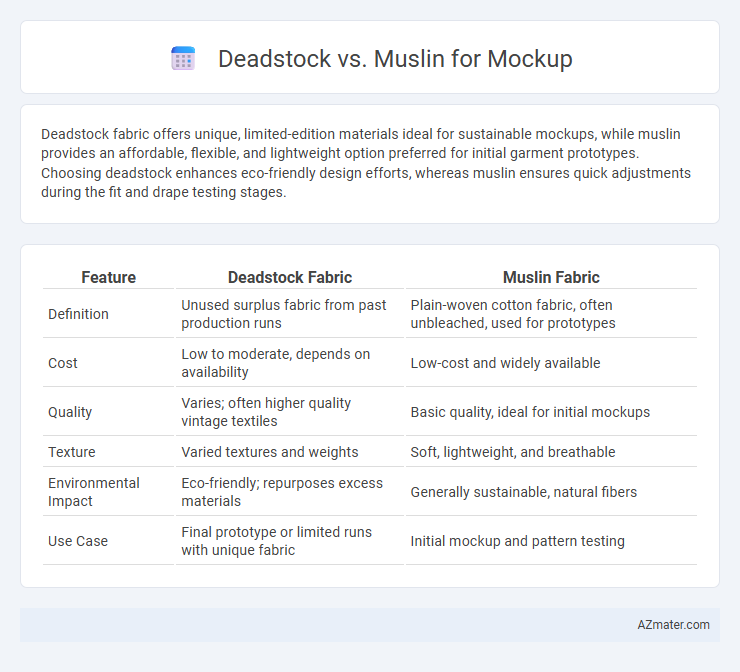Deadstock fabric offers unique, limited-edition materials ideal for sustainable mockups, while muslin provides an affordable, flexible, and lightweight option preferred for initial garment prototypes. Choosing deadstock enhances eco-friendly design efforts, whereas muslin ensures quick adjustments during the fit and drape testing stages.
Table of Comparison
| Feature | Deadstock Fabric | Muslin Fabric |
|---|---|---|
| Definition | Unused surplus fabric from past production runs | Plain-woven cotton fabric, often unbleached, used for prototypes |
| Cost | Low to moderate, depends on availability | Low-cost and widely available |
| Quality | Varies; often higher quality vintage textiles | Basic quality, ideal for initial mockups |
| Texture | Varied textures and weights | Soft, lightweight, and breathable |
| Environmental Impact | Eco-friendly; repurposes excess materials | Generally sustainable, natural fibers |
| Use Case | Final prototype or limited runs with unique fabric | Initial mockup and pattern testing |
Introduction to Deadstock and Muslin Fabrics
Deadstock fabric refers to leftover textiles from previous production runs, often prized for sustainability and unique patterns, while muslin is a lightweight, plain-woven cotton fabric commonly used for garment mockups due to its affordability and ease of manipulation. Deadstock offers an eco-friendly option by repurposing unused fabric, preserving resources and reducing waste, whereas muslin provides a consistent, neutral base ideal for testing garment fit and design before final production. Both materials play crucial roles in fashion prototyping, with deadstock contributing to eco-conscious practices and muslin ensuring precise garment construction.
Defining Deadstock Fabric: Pros and Cons
Deadstock fabric refers to unused, leftover textiles from previous production runs or seasons, offering a sustainable option for mockups by reducing waste and sourcing unique materials. It provides the advantage of high-quality, often rare fabrics at a lower cost, but can pose challenges due to limited availability and inconsistent quantities. Designers must balance the eco-friendly appeal and authenticity of deadstock with potential limitations in fabric continuity and color matching.
What is Muslin? Key Characteristics
Muslin is a lightweight, plain-weave cotton fabric widely used for creating mockups due to its affordability and ease of manipulation. Its breathability, softness, and slight transparency allow designers to test garment fit and drape accurately before final production. Unlike deadstock fabric, which consists of surplus or unused material, muslin offers consistent texture and weight, making it ideal for pattern testing and iterative design adjustments.
Cost Comparison: Deadstock vs Muslin
Deadstock fabric typically costs less than muslin due to its nature as surplus material from previous productions, offering affordable options for mockups without compromising on quality. Muslin, while generally more expensive, provides a consistent texture and weight ideal for precise garment fitting and draping during prototyping. Choosing between deadstock and muslin hinges on balancing budget constraints with the need for fabric consistency in the mockup process.
Sustainability and Environmental Impact
Deadstock fabric repurposes surplus textiles from past production runs, minimizing waste and reducing demand for new raw materials, thus promoting sustainable fashion practices. Muslin, often produced fresh from cotton, tends to have a higher environmental footprint due to agricultural inputs and water usage, though organic muslin offers a lower-impact alternative. Choosing deadstock for mockups supports circular economy principles by extending fabric life cycles and curbing textile landfill contributions.
Suitability for Fashion Mockups
Deadstock fabric offers unparalleled authenticity for fashion mockups, providing designers with vintage or surplus textiles that accurately represent final garment textures and colorways. Muslin, favored for its affordability and ease of manipulation, excels in initial prototyping stages due to its lightweight and plain weave, allowing quick adjustments without obscuring design details. Selecting between deadstock and muslin depends on the need for realistic fabric simulation versus cost-effective pattern testing in the fashion mockup process.
Durability and Performance in Prototyping
Deadstock fabric, sourced from unused vintage textile inventory, offers unique durability with tightly woven fibers that withstand multiple fittings during prototyping. Muslin, a plain-woven cotton fabric, provides lightweight performance perfect for quick fit tests but tends to wear out faster under repetitive handling. Choosing between deadstock and muslin for mockups depends on the balance between lasting fabric resilience and ease of manipulation during iterative design processes.
Availability and Sourcing
Deadstock fabric is often limited in availability due to its nature as surplus or outdated material, making sourcing a challenge for consistent mockup production. Muslin, on the other hand, is widely available and easy to source from numerous textile suppliers, ensuring reliable access for mockups. The choice between deadstock and muslin depends heavily on the desired aesthetic and the practicality of fabric procurement.
User Experience: Designer Perspectives
Deadstock fabric offers designers a sustainable and unique texture, enhancing the tactile user experience during mockup evaluation with authentic material qualities. Muslin, favored for its affordability and ease of manipulation, provides a neutral canvas that streamlines pattern adjustments without distracting from silhouette or fit. Choosing between deadstock and muslin directly influences the accuracy of garment drape simulation and ultimately impacts design refinement efficiency.
Choosing the Right Fabric for Your Mockups
Deadstock fabric offers unique prints and textures sourced from unused remnants, ideal for eco-friendly, eye-catching mockups that showcase sustainability. Muslin is a lightweight, plain-woven cotton fabric favored for its affordability, ease of draping, and neutral background, making it perfect for accurate garment fitting and design adjustments. Selecting between deadstock and muslin depends on your mockup goals: use deadstock to highlight creative fabric options and muslin for precise structural prototypes.

Infographic: Deadstock vs Muslin for Mockup
 azmater.com
azmater.com